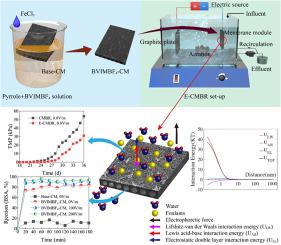Journal of Environmental Chemical Engineering ( IF 7.4 ) Pub Date : 2021-05-08 , DOI: 10.1016/j.jece.2021.105630 Qi Shen , DingYu Xing , Feiyun Sun , Wenyi Dong , Wentao Shang , Lingyan Zhao , Zijun Dong

|
Ceramic membrane bioreactor (CMBR) is an attractive alternative for wastewater treatment, although still subjects to fouling problem. This study facilely modified CM by oxidative polymerization of pyrrole with ionic liquid, to greatly enhance its conductivity and hydrophilic, and to sustainably mitigate fouling in an electric CMBR. Highly conductive ceramic membrane, BVIMBF4-CM, was facile obtained involving an ionic liquid 1-vinyl-3-butylimidazolium tetrafluoroborate (BVIMBF4) on the base CM (Base-CM). After simple modification, the electrical resistance of CM was reduced significantly from 1017 Ω/sq to 349 Ω/sq, while its water contact angle decreased from 44.0° to 30.5°. With the assistant of minute electric field, BVIMBF4-CM exhibited a high rejection efficiency of over 85% Cu2+, 65% Ni2+ and 93% bovine serum albumin (BSA). The interaction energy analysis verified BVIMBF4-CM itself prevent BSA from the membrane surface by the positive total interfacial energy. Meanwhile, the electrophoretic force provided by electric field enhanced the removal efficiency and antifouling capability of the BVIMBF4-CM. By using this modified CM to form an E-CMBR, a comparable removal efficiency as the CMBR could be stably obtained, which especially demonstrated significantly anti-fouling performance, as fouling rate decreased by 31.4~43.5%, and the total membrane resistance was only 60.8% of the Base-CM, under a minute electric field of 0.8 V/m. Enhanced hydrophilicity and conductivity of the BVIMBF4-CM take major responsible for this stable fouling alleviation in the E-CMBR. The new and facile method for CM modification proposed herein can serve as a reliable effort towards the application of antifouling E-CMBR system in wastewater treatment.
中文翻译:

离子液体促进吡咯的氧化聚合,以改性陶瓷膜,实现可持续的结垢控制
陶瓷膜生物反应器(CMBR)是废水处理的一种有吸引力的替代方法,尽管仍然存在结垢问题。这项研究通过吡咯与离子液体的氧化聚合,轻松地改性了CM,从而大大提高了其导电性和亲水性,并可持续地减轻了电CMBR中的结垢。容易获得的高导电性陶瓷膜BVIMBF 4 -CM涉及在基础CM(Base-CM)上形成离子液体的四氟硼酸1-乙烯基-3-丁基咪唑鎓四氟硼酸酯(BVIMBF 4)。简单修改后,CM的电阻从1017Ω/ sq显着降低到349Ω/ sq,而其水接触角从44.0°降低到30.5°。在微小电场的帮助下,BVIMBF 4-CM表现出高的排斥效率,超过85%的Cu 2 +,65%的Ni 2+和93%的牛血清白蛋白(BSA)。相互作用能分析证实BVIMBF 4 -CM本身可通过正的总界面能阻止BSA从膜表面进入。同时,电场提供的电泳力提高了BVIMBF 4 -CM的去除效率和防污能力。通过使用这种改性的CM形成E-CMBR,可以稳定地获得与CMBR相当的去除效率,特别是显示出显着的防污性能,污垢率降低了31.4〜43.5%,总膜阻力仅为在0.8分钟的电场下,基本CM的60.8% 伏/米 BVIMBF 4 -CM亲水性和导电性的增强是E-CMBR中这种稳定污垢缓解的主要原因。本文提出的用于CM改性的新的和容易的方法可以用作将防污E-CMBR系统应用在废水处理中的可靠努力。











































 京公网安备 11010802027423号
京公网安备 11010802027423号